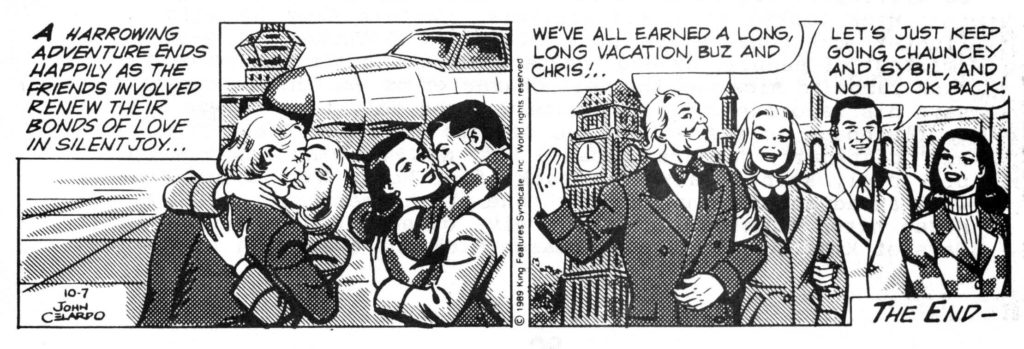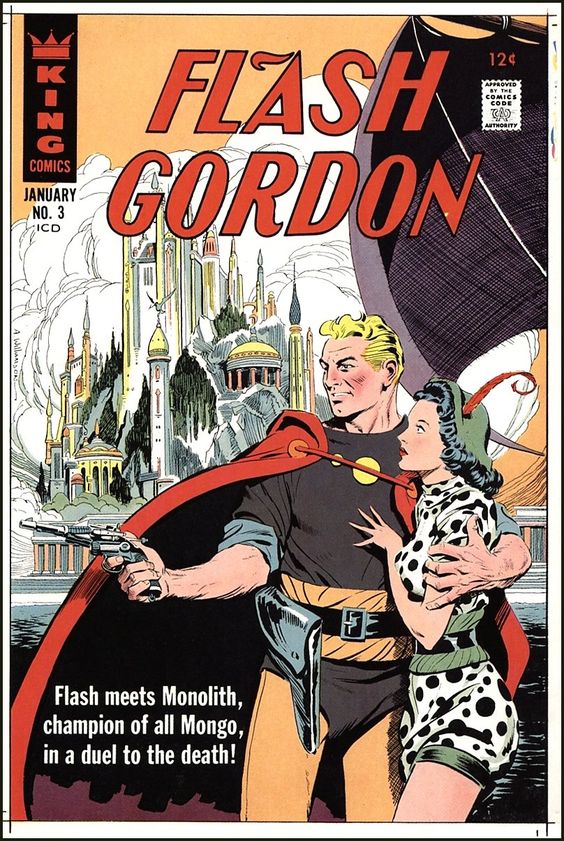Having premiered January 3, 1977, The Amazing Spider-man comic strip officially ended its run on October 21, 2023.
It had been in reprints since Roy Thomas and Alex Saviuk‘s run on the strip had come to an end. March 17, 2019 was their last Sunday with March 23, 2019 being the last daily.

March 17, 2019

March 23, 2019
The Spider-Man strip started in January of 1977 written by Stan Lee and drawn by John Romita. Following Stan Lee’s run on the strip Roy Thomas had written the strip uncredited for a number of years (more on that at SyFy.com). Artists that followed Romita included Fred Kida, Larry Lieber, and most recently Alex Saviuk with Joe Sinnott inks.
After the announcement of the strip’s finale, Joe Sinnott’s son Mark posted the following to his Dad’s Facebook page.

The following year, Joe Sinnott passed away (October 16, 1926 – June 25, 2020). Truly the end of an era!

With adventure strips being far and few between on today’s comics page, I thought it would be of interest to look at a few notable comic strip finales.
Note: Thanks to Allen Lane who posted a number of these to the Yahoo Classic Adventure Comic Strip Group.
Buz Sawyer was created by Roy Crane and first appeared November 1, 1943. Crane worked on the strip until his death in 1977.
For more in-depth info on Buz Sawyer I defer to Ray Contreras for the following info.
“Henry (Hank) Schlensker joined Crane right after the war (Schlensker had been a flyer in the war) and started working on the BUZ Sundays as soon as he joined Crane in 1946. In 1950, looking to ease his workload on the daily strip, Crane moved Schlensker from the Sundays to the daily strip. Around 1969, due to chronic ulcers, Roy Crane stepped back from the strip completely. Ed Granberry, who had been assisting on the writing, took it over completely; and Schlensker worked on the art for the daily, as he had basically for many, many years; only now without Crane’s involvement. Clark Haas and later Al Wenzel drew the Sunday after Crane switched Schlensker to the daily. Crane would look at the finished product, but after working years on the strip (both daily and Sunday), Schlensker and Granberry knew their stuff.“
Henry (Hank) Schlensker continued on Buz Sawyer after Crane’s death in 1977. After Schlensker’s retirement John Celardo took the reigns, working on Buz from 1983–1989. Upon Celardo’s sign-off, King Features discontinued the strip.

October 7, 1989
Buck Rogers by writer Philip Francis Nowlan and artist Dick Calkins debuted on January 7, 1929. Writers following Nolan included Rick Yager (who also drew it), Jack Lehti, Ray Russell, Fritz Leiber and Howard Liss. Artists following Calkins included Russell Keaton, Rick Yager and George Tuska.
Howard Liss and George Tuska’s finale strip appeared June 13, 1965.

June 13, 1965
The strip was given a second life in 1979 by writer Jim Lawrence and artist Gray Morrow, followed by writer Cary Bates and artist Jack Sparling. The finale strip appearing December 25, 1983.

December 25, 1983
One of the most memorable finales for a comic strip happened before the strip in question actually even ended. I’m talking of course of Milton Caniff’s Terry and the Pirates.
Looking to have the financial stability of ownership of his strip (something Caniff was denied at Tribune-News Syndicate with Terry), he accepted an offer from the Field Newspaper Syndicate to create a new strip that he would have ownership of. That strip would be Steve Canyon.
In Caniff’s iconic final Sunday page Terry says goodbye to Jane Allen as Caniff says goodbye to his Terry and the Pirates readers.
The story so far – Romance is in the air for Terry and Jane Allen until it’s discovered that her old flame, Snake Tumblin, is still alive and in a base hospital somewhere in Australia. Sacrificing his own happiness, Terry secures Jane a flight and escorts her to the airfield…

December 29, 1946
That last panel is the killer as Caniff adds a double meaning to the writing on the wall.

As pointed out by R.C. Harvey in the foreward to the Complete Terry and the Pirates Volume 6, the Sunday page was not the last strip Caniff drew. Because the Sunday pages were due well in advance of the dailies, the following daily strip – printed the day before the momentous final Sunday page – was actually the last strip drawn.

December 28, 1946
Caniff’s replacement on Terry and the Pirates would be George Wunder, who would go on to draw the strip for another 26 years. Here’s Wunder’s last Sunday page.

February 25, 1973
Terry and the Pirates would be revived in 1995 by Michael Uslan with art by the Brothers Hildebrandt. The following year they left the strip and were replaced by writer Jim Clark and artist Dan Spiegle. A year after that the strip was discontinued.

July 27, 1997
Secret Agent X-9 began on January 22, 1934. It was created by writer Dashiell Hammett (The Maltese Falcon) and drawn by artist Alex Raymond (Flash Gordon). Writers that followed Hammett in those early years included Don Moore and Leslie Charteris. The artists that followed after Raymond left the strip were Nicholas Afonsky and Austin Briggs. In the 1940s Mel Graff took over the writing and drawing chores, followed by Bob Lubbers (pseudonym “Bob Lewis”) in the 1960s.
From 1967 to 1980 the strip was written by Archie Goodwin and drawn by Al Williamson and relaunched as Secret Agent Corrigan. Here’s Goodwin and Williamson’s last strip from February 2, 1980.

February 2, 1980
Following Goodwin and Williamson was veteran cartoonist George Evans. Evans would write and draw the strip until 1996. Upon Evans’s decision to retire from producing the strip, King opted to discontinue it.

February 10, 1996
Another comic strip Alex Raymond started back in 1934 was the topper to his famous Flash Gordon strip, and that was Jungle Jim. Artists that followed Raymond on the strip were John Mayo and Paul Norris. After a 20 year run Jungle Jim wrapped up in 1954.

August 8, 1954
Rip Kirby premiered March 4, 1946 and was also created by Alex Raymond. Raymond’s work on Rip Kirby would win him the Reuben Award in 1949 for “Outstanding Cartoonist of the Year.”
Alex Raymond’s career was cut short in 1956, when at age 46, he was killed in a car crash. King Features sought out a replacement and found it in John Prentice. After John Prentice died in 1999 (after an amazing 43 year run on Rip Kirby) the decision was made by King Features to discontinue the strip. Frank Bolle would ghost the final week (to “ghost“ is when an artist fills in for another artist by mimicking his style).

June 26, 1999
Alex Raymond’s most renowned comic strip, Flash Gordon, first appeared January 7, 1934. It has had a number of artists and writers over the years (myself included), some of whom I highlighted on this Sunday page.

Quick side note: Dan Barry‘s assistant, Bob Fujatani (October 15, 1921 – September 6, 2020), gave a great interview in 2019 to the the Connecticut Post talking about his career in comics.
Here’s the link: At 97, Flash Gordon Artist Bob Fujitani Remembers Cartooning’s Golden Age
The Flash Gordon Dailies were discontinued on two occasions. The first in 1944 shows Flash, Dale and Dr. Zarkov in a ticker tape parade having returned from Mongo after successfully saving the Earth.

June 3, 1944
The dailies were revived in the 1950s with artist Dan Barry at the helm. In 1990 the dailies were taken over by Bruce Jones as writer and Ralph Reese as artist, followed by artist Gray Morrow upon Reese’s departure. A Buenos Aires studio of artists were hired in 1991 with writing alternating between Kevin Van Hook and Thomas Warkentin. The last daily would be in 1993

July 3, 1993
Meanwhile the Flash Gordon Sunday page had been running continuously since 1934. I started my tenure writing/drawing Flash on January 21, 1996. It was a fun run, but after a failed contract renegotiation, I deciding to bow out. My last strip, and Flash Gordon’s finale, appeared March 16, 2003.

March 16, 2003
The inspiration for my sign-off was the ending of the first Flash Gordon serial starring Buster Crabbe (Flash Gordon), Jean Rogers (Dale Arden) and Frank Shannon (Dr. Zarkov).

Originally I had a slightly more surreal ending planned in a Sunday page I did in collaboration with Mutts creator Patrick McDonnell. It was never meant to be though as the page was rejected by the editor up at King Features – his thoughts being “It really didn’t work as a Flash Gordon page.”
Patrick did an end run though and asked the editor, that if it wasn’t going to see print as a Flash Gordon page, could it be used as a Mutts page. The go ahead was given and it eventual saw print on March 23, 2003 as a Mutts Sunday page (with the Flash Gordon title kept intact).

March 23, 2003
UPDATE:
After 20 years of reprinting my run on the strip, King Features finally relaunched Flash Gordon January of 2024 with writer/artist Dan Schkade taking the helm.

You can follow Flash’s new adventures on Comics Kingdom.
Not to be missed!

Last but not least, check out the Daily Cartoonist for a Jim Keefe Bonus Round – where D. D. Degg follows up my comic strip finales with a list of when they first premiered.
Here’s the link…
First and Last – a Jim Keefe Bonus Round
